Outsourcing
流利说商务英语 Level 6 Unit 2 Part 3(一) Types of Outsourcing
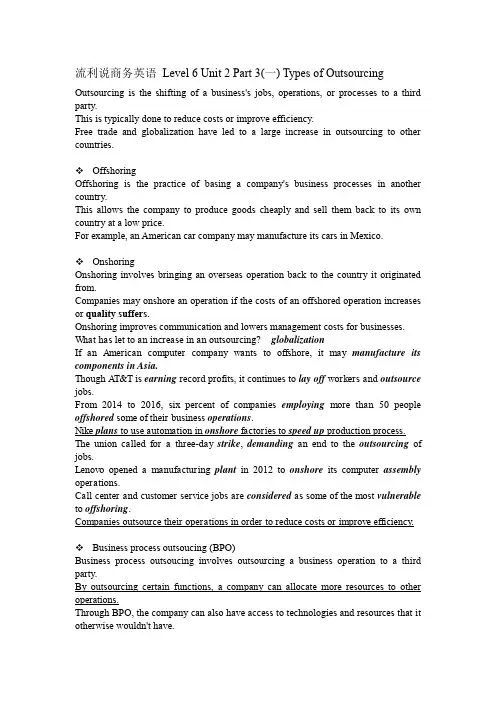
流利说商务英语Level 6 Unit 2 Part 3(一) Types of Outsourcing Outsourcing is the shifting of a business's jobs, operations, or processes to a third party.This is typically done to reduce costs or improve efficiency.Free trade and globalization have led to a large increase in outsourcing to other countries.OffshoringOffshoring is the practice of basing a company's business processes in another country.This allows the company to produce goods cheaply and sell them back to its own country at a low price.For example, an American car company may manufacture its cars in Mexico.OnshoringOnshoring involves bringing an overseas operation back to the country it originated from.Companies may onshore an operation if the costs of an offshored operation increases or quality suffers.Onshoring improves communication and lowers management costs for businesses. What has let to an increase in an outsourcing? globalizationIf an American computer company wants to offshore, it may manufacture its components in Asia.Though AT&T is earning record profits, it continues to lay off workers and outsource jobs.From 2014 to 2016, six percent of companies employing more than 50 people offshored some of their business operations.Nike plans to use automation in onshore factories to speed up production process. The union called for a three-day strike, demanding an end to the outsourcing of jobs.Lenovo opened a manufacturing plant in 2012 to onshore its computer assembly operations.Call center and customer service jobs are considered as some of the most vulnerable to offshoring.Companies outsource their operations in order to reduce costs or improve efficiency. Business process outsoucing (BPO)Business process outsoucing involves outsourcing a business operation to a third party.By outsourcing certain functions, a company can allocate more resources to other operations.Through BPO, the company can also have access to technologies and resources that it otherwise wouldn't have.Information technology outsourcing (ITO)Companies can use IT outsourcing for network infrastructure, software development, and maintenance.To save money, a company may outsource its IT management by using a third party rather than its own IT team.However, ITO can put a company at risk since it may allow a third party to access the company's sensitive data.Knowledge Process Outsourcing (KPO)Knowledge processing is the process of creating and spreading information.KPO provides expert-level knowledge and analysis on complicated fields, such as legal services and market research.Industries such as R&D, business analysis, and financial consultancy may outsource positions to find knowledgeable, qualified experts.The outsourcing of a business operation to a third party is called business process outsourcing.What is a risk letting a third party handle sensitive data?The data security may be compromised.An example of KPO services includes consulting.Bringing an overseas operation back to the country it originated from onshoring Global figures show that by the end of 2017, 31% of all IT services were outsourced. The Philippines has established itself in the global KPO market as the leading destination.。
委外加工管理
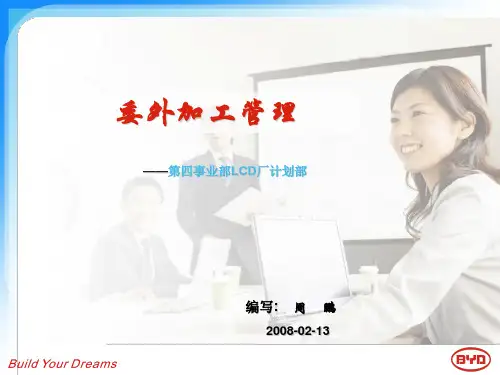
五,委外风险
竞争知识的丧失( ☆ 竞争知识的丧失(Loss of Competitive Knowledge) )
将重要组件委外给供应商,就等同於给竞争者机会 委外之后,公司就失去了100%以自己的想法去导入新设计的能力,而 亦须参酌供应商的意见
目标冲突( ☆ 目标冲突(Conflicting Objectives) )
品质部稽核;品质处理会议
◇ 委外帐目管理
物料帐单清单结;订单单清单结,杜绝拖延现象
Thank you!
See you next time!
�
七,委外流程
委外流程
八,委外加工管理重点
管理重点: ☆ 管理重点:
◇ 委外计划的合理性
包括委外物料与计划的衍接;委外计划与本公司需求的衍接;委外计划与供应商 实际情况的配合;
◇ 委外交期管理
承诺交期按时交货;交货异常做到反馈及更新交期;
◇ 委外进度管理
供应商生产日报,不定时稽核供应商
◇ 委外异常管理
*对模组化产品而言,掌握知识是重要的,至於有没有自制产能就显得次要
1)如果公司本身有这样的知识,将制造阶段委外就有成本降低的机会 2)如果公司既没有产能,也没有专业知识,委外就会是十分危险的策略.因为由供 应商 所发展出来的知识,很有可能会转移到竞争对手的产品上
*对整体性产品而言
1)如果公司既有知识也有产能,则自制会是适当的策略 2)如果公司两者均无,则该公司也许进到不该进的产业了
供应商和买家的目标常是不同且互相冲突的 Flexibility vs. long-term, stable commitments, etc. 例如,买家把各种零件委外出去的主要目的,就是要增加弹性,买 家可以透过生产力的调整,让供需之间能够更为吻合.不幸地,这 个目的和供应商希望买家可以承诺长期,稳定的订单相冲突 在产品设计的议题上,买家与供应商之间也有目标冲突: 买家希望有弹性,希望可以尽快解决问题 供应商的焦点在让成本降低,而这暗示对设计改变的回应力较慢
HR Outsourcing人力资源外包-外文文献
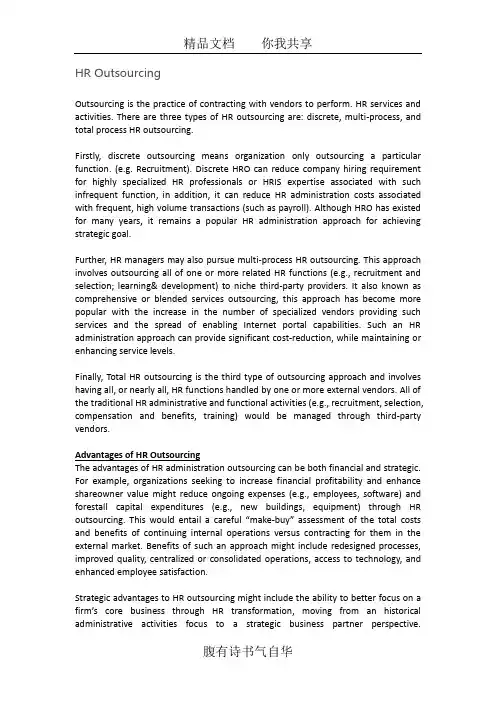
HR OutsourcingOutsourcing is the practice of contracting with vendors to perform. HR services and activities. There are three types of HR outsourcing are: discrete, multi-process, and total process HR outsourcing.Firstly, discrete outsourcing means organization only outsourcing a particular function. (e.g. Recruitment). Discrete HRO can reduce company hiring requirement for highly specialized HR professionals or HRIS expertise associated with such infrequent function, in addition, it can reduce HR administration costs associated with frequent, high volume transactions (such as payroll). Although HRO has existed for many years, it remains a popular HR administration approach for achieving strategic goal.Further, HR managers may also pursue multi-process HR outsourcing. This approach involves outsourcing all of one or more related HR functions (e.g., recruitment and selection; learning& development) to niche third-party providers. It also known as comprehensive or blended services outsourcing, this approach has become more popular with the increase in the number of specialized vendors providing such services and the spread of enabling Internet portal capabilities. Such an HR administration approach can provide significant cost-reduction, while maintaining or enhancing service levels.Finally, Total HR outsourcing is the third type of outsourcing approach and involves having all, or nearly all, HR functions handled by one or more external vendors. All of the traditional HR administrative and functional activities (e.g., recruitment, selection, compensation and benefits, training) would be managed through third-party vendors.Advantages of HR OutsourcingThe advantages of HR administration outsourcing can be both financial and strategic. For example, organizations seeking to increase financial profitability and enhance shareowner value might reduce ongoing expenses (e.g., employees, software) and forestall capital expenditures (e.g., new buildings, equipment) through HR outsourcing. This would entail a careful “make-buy” assessment of the total costs and benefits of continuing internal operations versus contracting for them in the external market. Benefits of such an approach might include redesigned processes, improved quality, centralized or consolidated operations, access to technology, and enhanced employee satisfaction.Strategic advantages to HR outsourcing might include the ability to better focus on a firm’s core business through HR transformation, moving from an historical administrative activities focus to a strategic business partner perspective.Organizations recognize that, more than ever, effective talent management may be the source of sustainable strategic advantage in a knowledge-based, global economy. However, many HR professionals are mired in day-to-day administrative tasks that preclude the value-added consulting, planning, and visioning activities required from them to achieve strategic goals. HR outsourcing could free HR professionals to focus on strategic issues (e.g., talent management, merger and acquisition due-diligence) while providing the firm with skilled professionals services in HR functional (e.g., recruitment, compensation) and administrative (e.g., government compliance and regulations) areas, powered by up-to-date technology (e.g., hardware, software). Disadvantages of HR Outsourcing.Although there are a number of financial and strategic reasons for considering HR administration outsourcing, there are also serious potential problems for firms who use the approach without fully understanding how to manage it to achieve desired goals. For example, firms who used HRO to achieve HR transformation and cost savings rated their success an average of 3 on a 5-point (1 = benefits not at all achieved and 5 = benefits fully achieved) scale. Thus, one big disadvantage of HRO is the likelihood that the organization will not achieve its strategic goals. Such a failure could have significant, negative impact on the organization’s ability to survive. Steps to minimize such a failure include realistic cost-benefit analyses, successful project planning and implementation, unambiguous goals and measures of HR outsourcing success, rigorous vendor assessment and selection processes, and skilled vendor contract negotiation, management, and auditing. Indeed, one of the primary responsibilities of HR administration managers in an outsourcing environment is to ensure that the contract terms and fulfilled on a daily basis and that corrective actions are immediately taken when failures occur.Another disadvantage of HR outsourcing includes the loss of institutional expertise in the outsourced functions, making an HR outsourcing decision reversal difficult or impossible. Frequently, when outsourcing is undertaken, subject matter experts (e.g., selection) are reassigned or released. This can be a serious strategic error if the vendor is unable to fulfill its contractual obligations. As noted above, an organization would be unwise to outsource core or strategic HR planning functions because of the possibility that competitors may learn its plans from vendors. In addition, loss of internal strategic HR expertise may be devastating to an organization over time. Moreover, HR organizations may lack the contract management expertise to oversee the vendor and hold it accountable for contract terms, compounding its problems. Other potential problems include security risks in multi-vendor outsourcing, internal employee and manager resistance, compliance failures (e.g., Sarbanes-Oxley), and cultural clashes between the organization and its vendors.In summary, HR outsourcing is another approach to HR administration that offers potential for cost reduction, process improvement, and employee satisfaction. However, managers of HR administrative functions must be highly skilled at usingHRO strategically to achieve organizational goals.出师表两汉:诸葛亮先帝创业未半而中道崩殂,今天下三分,益州疲弊,此诚危急存亡之秋也。
32个新兴经济词汇

11、电子商务(Electronic Commerce)
在网路新经济时代,电子商务(Electronic Commerce)成为企业新兴的营运模式,透过网际 网路的网网相连,企业建构电子平台,进行交易与 服务。 所谓电子商务的定义,由通讯的角度解释,在 利用电话线、网际网路等方式,传递资讯、产品、 服务或付款服务;由企业流程的角度来看,就是线 上商业交易与工作流程自动化的电脑技术的应用。 一般而言,电子商务的內容包括:资讯流、资金流、 商流与物流。
学习型组织(Learning Organization), 美国学者彼得.圣吉(Peter M. Senge)在 「第五项修炼」(The Fifth Discipline)一书 中提出此管理观念,企业应建立学习型组织, 其涵义为面临变遭剧烈的外在环境,组织应 力求精简、扁平化、弹性因应、终生学习、 不断自我组织再造,以维持竞争力。
俗称企业e化的企业电子化,应包括五 大块核心项目:电子商务(Electronic Commerce)、企业资源规划(ERP, Enterprise Resource Planning)、顾客关系 管理(CRM, Customer Relationship Management)、供应链管理(SCM, Supply Chain Management)、知识管理(KM, Knowledge Management)。藉由网际网路 无远弗界的特性,企业运用此五项资讯化工 具,即能达到电子化、全面自动化的流程。 企业导入电子商务,目的在于符合顾客 需求,降低营运成本,增加商机,创造企业 新价值链的极大化。
6、人力资源管理(HRM, Human Resource Management)
人力资源管理(HRM, Human Resource Management)的定义为,组织中人力资源的管理, 意指一个组织对人力资源的获取、维护、激励与运 用与发展的全部管理过程与活动。 所谓人力资源的意义为,一个社会所拥有的智 力劳动和体力劳动能力的人们之总称,包括数量与 质量两种。人力资源的观念,起源自60年代,企业 界之前名称为「人事管理」,主要的差別,在于人 力资源视员工为组织的资产,因此需要为员工发展 各种人力资源规划与招募考选、薪资福利、教育训 练、职涯发展等服务功能,而非传统局限于人事行 政的业务。
外包的起源_发展及研究现状综述
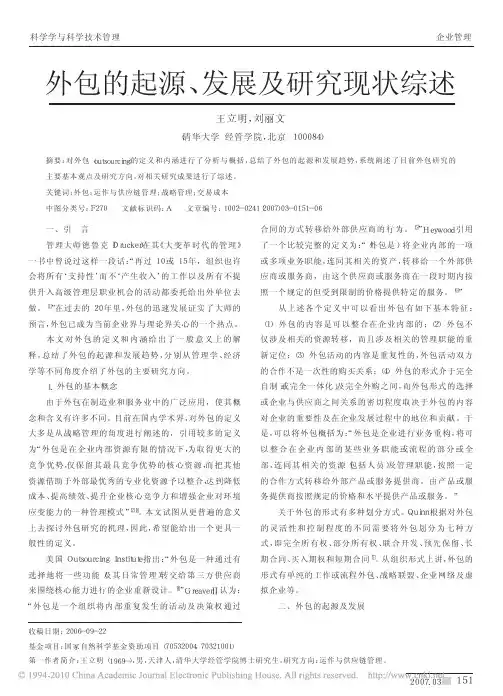
一、引言管理大师德鲁克(Drucker)在其《大变革时代的管理》一书中曾说过这样一段话:“再过10或15年,组织也许会将所有‘支持性’而不‘产生收入’的工作以及所有不提供升入高级管理层职业机会的活动都委托给出外单位去做。
[1]”在过去的20年里,外包的迅速发展证实了大师的预言,外包已成为当前企业界与理论界关心的一个热点。
本文对外包的定义和内涵给出了一般意义上的解释,总结了外包的起源和发展趋势,分别从管理学、经济学等不同角度介绍了外包的主要研究方向。
1.外包的基本概念由于外包在制造业和服务业中的广泛应用,使其概念和含义有许多不同。
目前在国内学术界,对外包的定义大多是从战略管理的角度进行阐述的,引用较多的定义为“外包是在企业内部资源有限的情况下,为取得更大的竞争优势,仅保留其最具竞争优势的核心资源,而把其他资源借助于外部最优秀的专业化资源予以整合,达到降低成本、提高绩效、提升企业核心竞争力和增强企业对环境应变能力的一种管理模式”[2][3]。
本文试图从更普遍的意义上去探讨外包研究的机理,因此,希望能给出一个更具一般性的定义。
美国OutsourcingInstitute指出:“外包是一种通过有选择地将一些功能(及其日常管理)转交给第三方供应商来围绕核心能力进行的企业重新设计。
[4]”GreaverⅡ认为:“外包是一个组织将内部重复发生的活动及决策权通过合同的方式转移给外部供应商的行为。
[5]”Heywood引用了一个比较完整的定义为:“(外包是)将企业内部的一项或多项业务职能,连同其相关的资产,转移给一个外部供应商或服务商,由这个供应商或服务商在一段时期内按照一个规定的但受到限制的价格提供特定的服务。
[6]”从上述各个定义中可以看出外包有如下基本特征:(1)外包的内容是可以整合在企业内部的;(2)外包不仅涉及相关的资源转移,而且涉及相关的管理职能的重新定位;(3)外包活动的内容是重复性的,外包活动双方的合作不是一次性的购买关系;(4)外包的形式介于完全自制(或完全一体化)及完全外购之间,而外包形式的选择或企业与供应商之间关系的密切程度取决于外包的内容对企业的重要性及在企业发展过程中的地位和贡献。
bpo行业分析
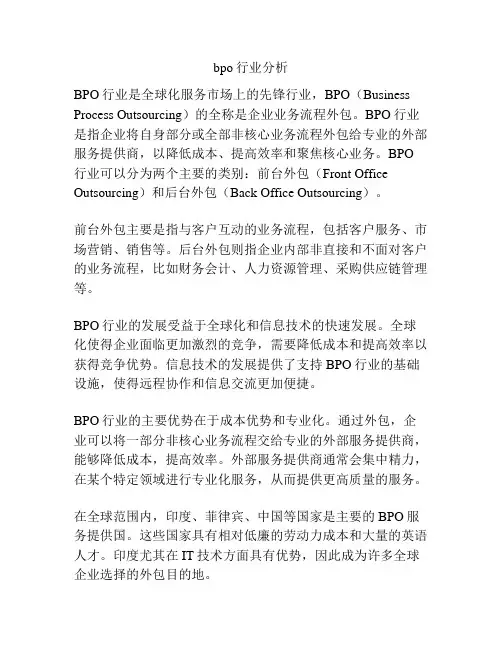
bpo行业分析BPO行业是全球化服务市场上的先锋行业,BPO(Business Process Outsourcing)的全称是企业业务流程外包。
BPO行业是指企业将自身部分或全部非核心业务流程外包给专业的外部服务提供商,以降低成本、提高效率和聚焦核心业务。
BPO 行业可以分为两个主要的类别:前台外包(Front Office Outsourcing)和后台外包(Back Office Outsourcing)。
前台外包主要是指与客户互动的业务流程,包括客户服务、市场营销、销售等。
后台外包则指企业内部非直接和不面对客户的业务流程,比如财务会计、人力资源管理、采购供应链管理等。
BPO行业的发展受益于全球化和信息技术的快速发展。
全球化使得企业面临更加激烈的竞争,需要降低成本和提高效率以获得竞争优势。
信息技术的发展提供了支持BPO行业的基础设施,使得远程协作和信息交流更加便捷。
BPO行业的主要优势在于成本优势和专业化。
通过外包,企业可以将一部分非核心业务流程交给专业的外部服务提供商,能够降低成本,提高效率。
外部服务提供商通常会集中精力,在某个特定领域进行专业化服务,从而提供更高质量的服务。
在全球范围内,印度、菲律宾、中国等国家是主要的BPO服务提供国。
这些国家具有相对低廉的劳动力成本和大量的英语人才。
印度尤其在IT技术方面具有优势,因此成为许多全球企业选择的外包目的地。
然而,BPO行业也面临一些挑战。
首先是安全和隐私问题。
企业外包业务流程需要考虑数据的安全性和保密性,确保外部服务提供商能够妥善处理客户的敏感信息。
其次是跨文化管理问题。
由于BPO行业通常涉及全球化服务,企业需要面对不同文化和价值观的差异,这就需要跨文化管理能力。
第三是服务质量问题。
虽然外包可以提高效率和专业化程度,但有时候外部服务提供商的服务质量可能无法达到企业的预期,这就需要企业与外部服务提供商进行有效合作和管理。
总之,BPO行业作为全球化服务市场上的先锋行业,为企业提供了降低成本、提高效率和聚焦核心业务的机会。
第十四章企业物流外包
六、物流服务承包商的类型 (一)按照提供物流服务的种类分类 1. 以资产为基础的物流服务提供商 2. 以管理为基础的物流服务提供商 3. 综合物流服务提供商
31
(二)按照所属的物流市场进行分类 1. 操作性的物流公司 2. 行业倾向性的物流公司 3. 多元化的物流公司 4. 顾客化的物流公司
34
市场的变化给物流和供应链的管理提出了 更高的期望,要求将现代科技、EC和传 统的商业运营模式结合起来,以在供应链 中构造一个将供应链的外包形为链接的统 一单位,而不是像以前的单独行为。 供应链管理中的外包行为的变化促使很多 的3PL和咨询机构和技术开发商开展协作 ,以增强竞争力,由此产生了4PL。
29
五、企业物流外包的形式 1. 物流业务完全外包 2. 部分外包 3. 物流系统接管(企业将原有的物流系统
卖给或承包给3PL供应商,即物流社会 化,第三方接管其系统并雇佣原来的职 工) 4. 战略联盟(企业与3PL合资或其他企业 合资,保留物流设施的部分产权,并在 物流作业中保持参与)
30
5. 物流系统剥离(将物流系统剥离,成为 独立的子公司)
15
(9)物资采购 (10)工业包装 (11)退货处理 (12)废弃物处理 (13)运输 (14)仓库管理 (15)流通加工 (16)配送 表11.1,表11.2欧美3P络化 (2)关系合同化 (3)功能专业化 (4)服务个性化
17
二、企业选择3PL的原因 专业化的分工要求企业扬长避短。 1. 3PL具有专业水平和相应的物流网络。 2. 拥有规模经济效益。 3. 有助于减少资本投入。 4. 资源优化配置。 5. 3PL公司信息技术的优势。(特有的信
What is outsourcing
What is outsourcing?Outsourcing refers to a company that contracts with another company to provide services that might otherwise be performed by in-house employees. Many large companies now outsource jobs such as call center services, e-mail services, and payroll. These jobs are handled by separate companies that specialize in each service, and are often located overseas.Outsourcing also allows companies to focus on other business issues while having the details taken care of by outside experts. This means that a large amount of resources and attention, which might fall on the shoulders of management professionals, can be used for more important, broader issues within the company. The specialized company that handles the outsourced work is often streamlined, and often has world-class capabilities and access to new technology that a company couldn't afford to buy on their own. Plus, if a company is looking to expand, outsourcing is a cost-effective way to start building foundations in other countries.There are many reasons that companies outsource various jobs, but the most prominent advantage seems to be the fact that it often saves money. Many of the companies that provide outsourcing services are able to do the work for considerably less money, as they don't have to provide benefits to their workers and have fewer overhead expenses to worry about.There are some disadvantages to outsourcing as well. One of these is that outsourcing often eliminates direct communication between a company and its clients. This prevents a company from building solid relationships with their customers, and often leads to dissatisfaction on one or both sides. There is also the danger of not being able to control some aspects of the company, as outsourcing may lead to delayed communications and project implementation. Any sensitive information is more vulnerable, and a company may become very dependent upon its outsource providers, which could lead to problems should the outsource provider back out on their contract suddenly.。
服务外包的含义与案例
服务外包的含义与案例1、根据《商务部关于实施服务外包“千百十工程”的通知》,“服务外包企业”系指根据其与服务外包发包商签订的中长期服务合同向客户提供服务外包业务的服务外包提供商;“服务外包业务”系指服务外包企业向客户提供的信息技术外包服务(ITO)和业务流程外包服务(BPO),包括:业务改造外包、业务流程和业务流程服务外包、应用管理和应用服务等商业应用程序外包、基础技术外包(IT、软件开发设计、技术研发、基础技术平台整合和管理整合)等;“国际(离岸)服务外包”系指服务外包企业向境外客户提供服务外包业务。
2、服务外包(Outsourcing)包括IT外包(IT Outsourcing)和商务外包(Business Outsourcing)两部分。
IT外包分为IT服务外包、应用管理、应用服务、网络和桌面服务、基础架构支持服务。
商务外包分为商务流程外包BPO(Business Process Outsourcing)和流程服务(Processing)。
其中,BPO是将一个或多个完整的业务流程或整个业务职能的管理工作外包给外部服务商,其绩效主要与客户服务以及战略性商业价值挂钩。
流程服务涉及管理和执行的转移,以使用户和外部合作伙伴之间的交流实现自动化。
(来源:IDC)外包是指企业将生产或经营过程中的某一个或几个环节交给其他(专门)公司完成。
外包的范围按工作性质可分为―蓝领外包‖和―白领外包‖。
―蓝领外包‖指产品制造过程外包。
―白领外包‖亦称―服务外包‖,指技术开发与支持其他服务活动的外包。
其中技术开发与支持的外包一般采用一次性项目合同的方式寻求第三方专业公司的服务,称为―合同外包‖;其他服务活动的外包多通过签定长期合同的方式交由专业外包提供商进行,称为―职能外包‖。
目前,服务外包广泛应用于IT服务、人力资源管理、金融、会计、客户服务、研发、产品设计等众多领域,服务层次不断提高,服务附加值明显增大。
根据美国邓百氏公司的调查,全球的企业外包领域中扩张最快速的是IT服务、人力资源管理、媒体公关管理、客户服务、市场营销。
离岸外包
离岸外包(Offshore Outsourcing)离岸外包概述离岸外包指外包商与其供应商来自不同国家,外包工作跨国完成。
由于劳动力成本的差异,外包商通常来自劳动力成本较高的国家,如美国、西欧和日本,外包供应商则来自劳动力成本较低的国家,如印度、菲律宾和中国。
离岸外包(Offshore Outsourcing)开始于1990年。
起初离岸供应商称之为辅助的应用开发帮助(supplemental application development help)。
从1995年到2005年,在离岸外包市场上已经出现和将要出现以下五个主要的进步:1、开始于1995年,Y2K问题使离岸市场合法化,印度供应商获得了一些小的定单。
尽管有些曲折,但交易非常成功。
2、印度供应商增加在美国的营业,增加他们在美国公司中的智力份额,逐渐成为全球服务供应商。
3、同时,最大的基于美国业务的外包服务提供商已经开始讨论并增强他们自己的离岸外包的能力。
起初他们使用离岸的劳动力,现在他们正在建设离岸子公司。
4、我们正在看到,美国和印度供应商之间的交叉合作,这些合作也扩展到离岸国家,如立陶宛、菲律宾、墨西哥和加拿大还有南美。
我们现在也看到了离岸BPO(Business Process Outsourcing,业务过程外包)和联系中心。
5、最大的印度外包供应商已经开始将IT供应链从他们的构建和维护应用的核心竞争力提升到完成其他的增值活动,例如,人力提供中心(manning help desks)和处理业务过程。
他们期望能获得为美国服务的提供商资格并达到真正的全球化。
由于离岸外包的概念最早起源于美国,外包的地域概念将美国国内为在岸外包(Onshore Outsourcing),北美等周边国家与地区的外包成为近岸外包(Nearshore Outsourcing),而较远地区的外包,如外包到印度、中国及俄罗斯,则称为离岸外包(Offshore Outsourcing)。
- 1、下载文档前请自行甄别文档内容的完整性,平台不提供额外的编辑、内容补充、找答案等附加服务。
- 2、"仅部分预览"的文档,不可在线预览部分如存在完整性等问题,可反馈申请退款(可完整预览的文档不适用该条件!)。
- 3、如文档侵犯您的权益,请联系客服反馈,我们会尽快为您处理(人工客服工作时间:9:00-18:30)。
CORE COMPETENCE
INDIVIDUAZIONE DELLE CORE COMPETENCE: • Devono fornire un potenziale accesso ad un’ampia varietà di mercato (ad es. mercato dei display); • Devono portare un contributo significativo al beneficio percepito dal cliente in relazione al prodotto finale; • Non devono essere imitabili dai concorrenti.
L’OUTSOURCING
La gestione delle competenze
OUTSOURCING
ECCELLENZA IMPRENDITORIALE?
NON E’ FUNZIONE DELLA DIMENSIONE … … MA E’ FRUTTO DELLE COMPETENZE AZIENDALI
DI BASE
How do you determine your company’s core competencies?
The thought process requires a sequiential look back at everithing that goes on within the company: • What do we do? • What do we do well? • What do we do exceptionally well? • What do we do exceptionally well that adds value that our customers perceive? • What do we do exceptionally well that our customers perceive adds more value than that provided by our competitors?
RESISTENZE
1. 2. 3. 4. Conflitti tra funzioni Fornitori esterni Costi “evitabili” Pregiudizi. “Paura del vuoto”
SVANTAGGI DELL’OUTSOURCING 1. Posizione irreversibile 2. Perdita di coordinamento 3. Perdita di controllo sul fornitore 4. Perdita di motivazione
OUTSOURCING
A SUPPORTO DELLE STRATEGIE DI ASA
“STRATEGIC SOURCING MODEL”
Un approccio interessante per la decisione strategica di outsourcing
ENFASI SULLA VARIABILE TECNOLOGICA COME ELEMENTO PER LE SCELTE DI ARTICOLAZIONE E STRUTTURA DELE ATTIVITA’
CONTROLLO DELLE CONOSCENZE DIFFERENZIALI L’impresa ha la possibilità di concentrarsi su quei pochi stadi del processo produttivo che richiedono competenze differenziali, riducendo la eterogeneità degli investimenti, aumentando l’efficienza, aumentando le conoscenze
Basso
Alto
GRADO DI VULNERABILITA’ STRATEGICA
Basso
OUTSOURCING
A SUPPORTO DELLE STRATEGIE DI ASA
LA CATENA DEL VALORE (PORTER)
INDIVIDUA LE ATTIVITA’ CHE CONTRIBUISCONO A REALIZZARE LE STRATEGIE E CHE CONSENTONO VANTAGGI IN TERMINI DI COSTO E/O DIFFERENZIAZIONE. PUNTI DI FORZA COMPETENZE
CREARE UN’ORGANIZZAZIONE CHE RUOTA INTORNO ALLE CORE COMPETENCE
OUTSOURCING 2014
TIPI DI SERVIZI
Informatica Consulenza aziendale Comunicazioni Ingegneria Ambiente
PERCENTUALE DI UTILIZZO 32
24 23 13 8
I PRINCIPI DELL’OUTSOURCING
L’IMPRESA: 1. Concentra le risorse sulle parti del prodotto e del servizio che considera “critiche” 2. Ricorre all’esterno quando i fornitori hanno un vantaggio comparativo rilevante 3. Ricorrendo all’esterno, crea le premesse al benchmarking
SVOLGERE LE ATTIVITA’ TIPICHE IN MANIERA SUPERIORE RISPETTO AI CONCORRENTI
OUTSOURCING
CONCETTO DI ESTERNALIZZAZIONE FAVORISCE
Ogni qualvolta un’azienda produce al suo interno servizi che altri possono comperare o svolgere con maggiore efficienza e/o efficacia, essa sacrifica vantaggio competitivo
I VANTAGGI DELL’OUTSOURCING
1. 2. 3. 4. 5. 6. Flessibilità Costi bassi e rischi bassi Strategic focus Minore complessità Acquisire conoscenze Innovazione tecnologica
OUTSOURCING
CORE COMPETENCE
Prodotti finali
1
2
Business 1
3
4
5
Business 2
6
7
8
Business 3
9
10
11
Business 4
12
Prodotto base 2 Prodotto base 1
Competenza di base 1 Competenza di base 2
OUTSOURCING
CORE COMPETENCE
SEMPLIFICARE I PROCESSI AZIENDALI
FOCALIZZANDO L’ATTENZIONE DEL MANAGEMENT SU DI ESSI
INDIVIDUANDO I PUNTI DI FORZA
FAR LEVA SULLE PROPRIE CAPACITA’ DI BASE
Vantaggi competitivi a confronto con la variabilità strategica
Alto
POTENZIALE DI VANTAGGI COMPETITIVI
Controllo strategico (produzione interna)
E’ necessario un moderato controllo (joint venture o contratti) E’ sufficiente un modesto controllo (acquisito quando è necessario)
IMPRESA A RETE Fattore di successo: Capacità aziendale di chiamare a raccolta le migliori competenze, i migliori processi, le migliori tecnologie, attraverso la partnership con imprese che nelle varie aree siano in grado di offrire servizi di eccellenza
OUSOURCING
SIGNIFICA ACQUISTARE ALL’ESTERNO QUANTO IN PRECEDENZA ERA PRODOTTO
ALL’INTERNO.
OUTSOURCING
CORE COMPETENCIES
• se
le conoscenze differenziali diminuiscono •e, quindi, aumentano le attività banali •aumentano i potenziali competitori •diminuiscono le barriere difensive
OUTSOURCING
• PRODURRE INTERNAMENTE DANDO LUOGO AD UN ACCENTRAMENTO DELLE RISORSE (MAKE)
